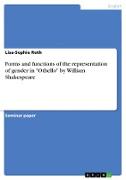- Start
- Forms and functions of the representation of gender in "Othello" by William Shakespeare
Forms and functions of the representation of gender in "Othello" by William Shakespeare
Angebote / Angebote:
Seminar paper from the year 2018 in the subject English Language and Literature Studies - Literature, grade: 1, 3, University of Cologne, language: English, abstract: The paper discusses the forms and functions of the representation of gender in William Shakespeare's "Othello".Beginning with an overview of gender stereotypes and social hierarchies in Shakespeare's times, referencing mainly Susan Almussen's "Gender, Culture and Politics in England", as well as Stephen Orgel's "Shakespeare, sexuality and gender", the uncovered results shall then be referred to the gender representation in the play at hand. Given the patriarchy present in early modern ages, the author will examine in how far this patriarchy is presented in Othello and how the female characters behave or should behave according to it. One of the male characters, Iago, stands behind most of the dramatic actions of the play - Using Prof Dr Heinz Antor's "Constructing Alterity: Race, Gender, and the Body in Shakespeare's Othello", the next chapter has the aim to examine the motivations behind his mischievous plans and how and against whom he performs them. Then the author is going to answer where the differences between male and female friendships lie and how they are characterized throughout the play. The last chapter mainly refers to Emily C. Bartels' "Strategies of Submission: Desdemona, the Duchess, and the Assertion of Desire", and tends to find out if and how the female characters revolt against the patriarchal society they live in and which does not give them much room to criticize or even revolt against the social hierarchies.
Folgt in ca. 10 Arbeitstagen
